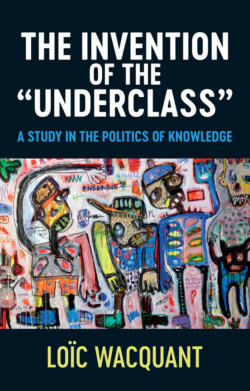Читать книгу The Invention of the 'Underclass' - Loic Wacquant - Страница 13
“The refuse of Europe”
Оглавление“The refuse of Europe . . . congregate in our great cities and send forth wretched progeny, degraded in the deep degradation of their parents – to be the scavengers, physical and moral, of our streets. Mingled with these are also the offcast children of American debauchery, drunkennesss, and vice. A class more dangerous to the community . . . can scarcely be imagined.”
American Bible Society, Annual Report, 1857
By the 1870s, the idiom of wilderness was transferred from the Western frontier to the urban frontier, and the inner ring of cities portrayed as an abyss of anonymity, depravity, and artificiality, whose “semi-barbarous” residents threatened to capsize the societal edifice in toto. Theories of hereditary degeneracy and moral delinquency were combined to develop the doctrine and practice of “scientific philanthropy” based on the partitioning of the urban poor into worthy and vicious.27 Of particular concern was the size, growth, and menace of a submerged stratum of the urban proletariat known as the residuum – a notion borrowed from Charles Booth’s mammoth survey of the London poor28 – nested in the most squalid tenements of the metropolis. Criminality, casual work, moral dissolution, and family disintegration were the defining features of this fearsome and unreformable population, which makes it a close ancestor to the “underclass.”
During the Gilded Age, the anxiety of the Anglo-Saxon bourgeoisie took on hysterical proportions in the face of “the triple menace of class warfare, alien radicalism, and urban mass violence.”29 Colossal demographic changes turned the old urban centers into the province of foreign migrants splintered by language and religion, spawned the squalor of the slums, and fueled the growth of patronage politics. Religious groups, such as the Salvation Army and its “slum brigades,” and the charity organization movement sprang into action, based on “the assumption that the urban poor had degenerated morally because the circumstances of city life had cut them off from the elevating influence of their moral betters” – shades of the lament that the “underclass” lacks proper “mainstream role models” a century later.
To battle indolence and ameliorate the character of the poor required investigation, visitation, and the compiling of dossiers made available to prospective landlords, employers, banks, and even the police.30 Imported from London, the settlement house movement led by Jane Addams favored environmental remedies over individual solutions and made the neighborhood the focus of inquiry and remediation, anticipating its adoption by the Chicago school of sociology two decades later. The urban reform of the 1890s thus followed two tracks: a coercive approach seeking to rein in the immoral behavior of the poor through surveillance and supervision in their own best interest (Jacob Riis summed up this perspective with the formula, “Those who would fight for the poor must fight the poor to do it”), and an environmentalist approach aiming to ameliorate the tenements with bathhouses, parks, and playgrounds suited to restoring the moral health of the proletariat.31
Faced with the pestilence and violence of the teeming immigrant working class, the bourgeoisie fled to the emerging suburbs, also imported from England and consciously crafted as the sociomoral opposite of the city. Inspired by Puritanism, the ideal of urbane living among the American bourgeoisie has always been suburban, that is, socially homogeneous, ethnically exclusive, spatially separate, and bucolic.32 The suburb promoted and protected middle-class ideals of property, familial privacy, and moral propriety; it allowed the gracious single-family home, set in its large green lawn and drained of profane concerns, to function as the cradle of domesticity and religiosity. It expressed, not just the desire for self-seclusion, but also the fear of the class and ethnic other as well as trepidation at the rapid social changes wrought by the market.33 The suburb thus defined itself through a series of homological oppositions that systematically devalued the first term: city/suburb, industry/family, poor/rich, ethnic promiscuity/ethnic purity, paganism/religiosity, artificial/natural, and depravity/morality. It is a key “asymmetric counter-concept” of America’s urban imagination.34
During the Progressive Era, the taming of the city, viewed as a continued menace to the state and the nation, took two forms. The first strand extended the coercive and moralistic approach to stimulate crusades against such ills of urban life as sexual deviancy (the brothel) and intemperance (the saloon). The second, with Jane Addams as its figurehead, drew on a more sanguine view of the metropolis; it embraced positive environmentalism to remake the urban setting in ways believed to nourish sound habits and good conduct among the laboring class. The development of tenement reform, parks and playgrounds, civic pageants, and municipal art, not to forget “temperance saloons” offering masculine camaraderie with no alcohol, partook of this approach. So did the teaching of English, ethnic crafts, and occupational and domestic skills. Such settlement work, moreover, had the virtue of reducing the isolation of the urban poor from their social betters which, together with congestion, was believed to be the main source of their moral condition.35
